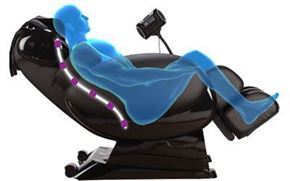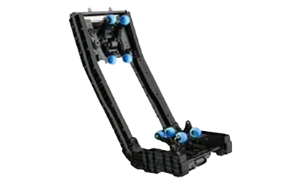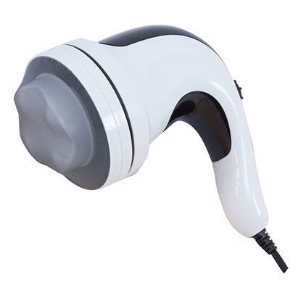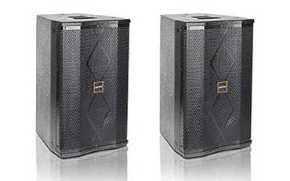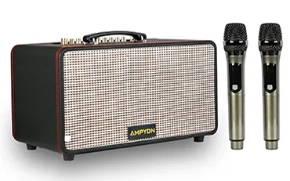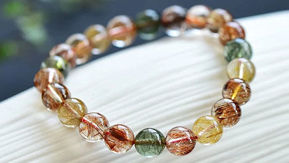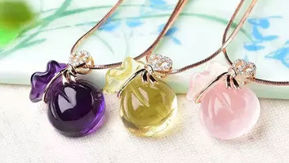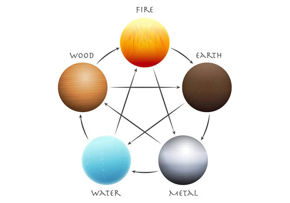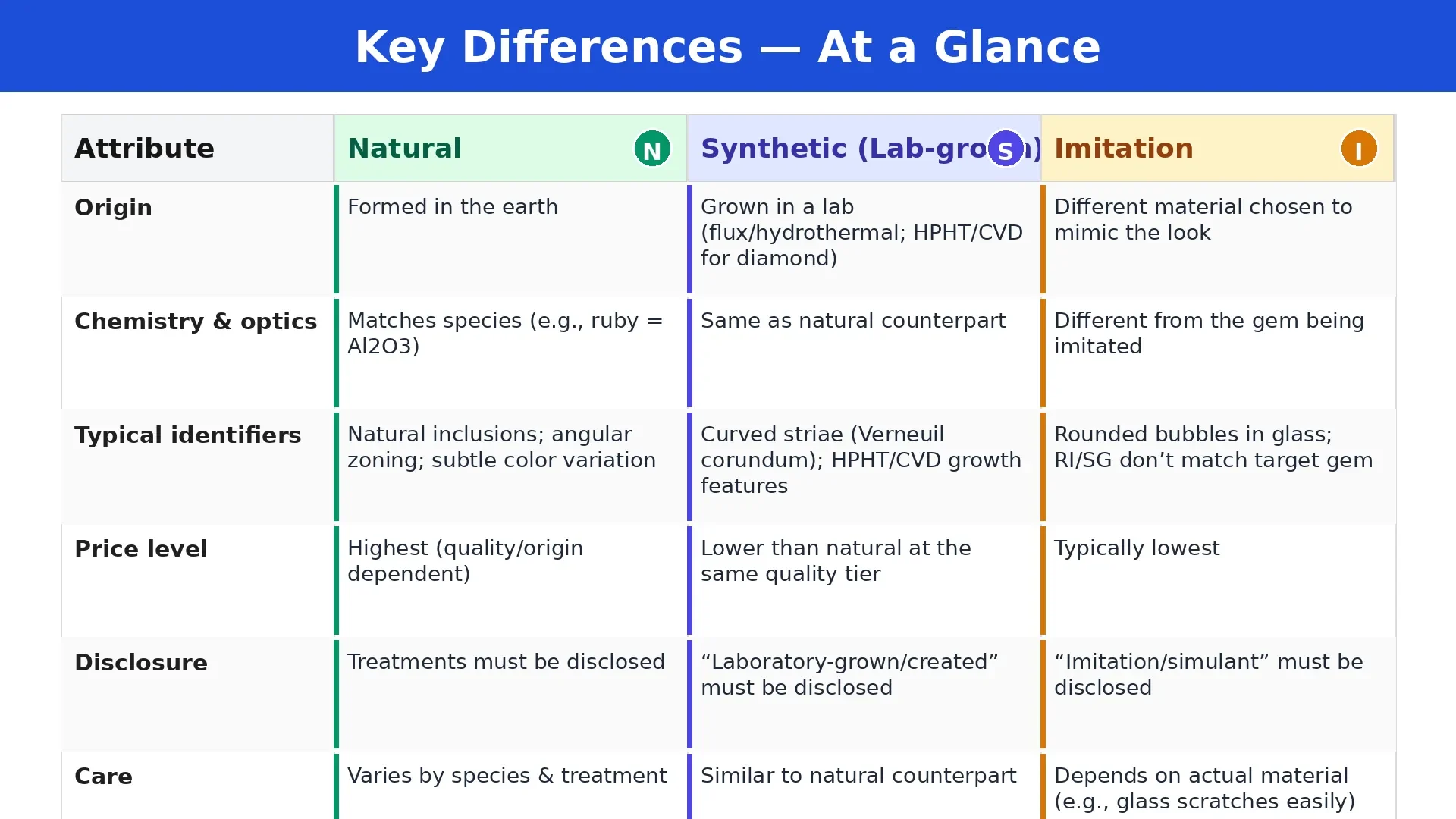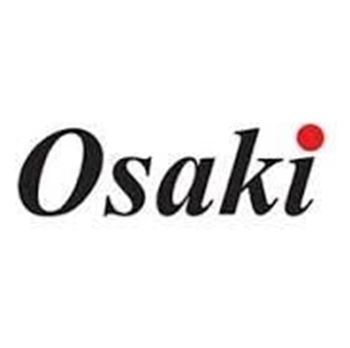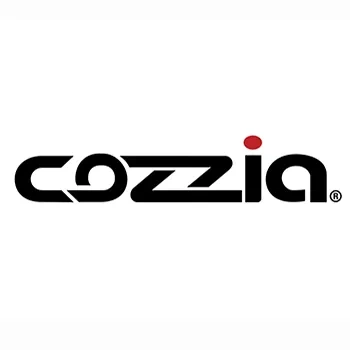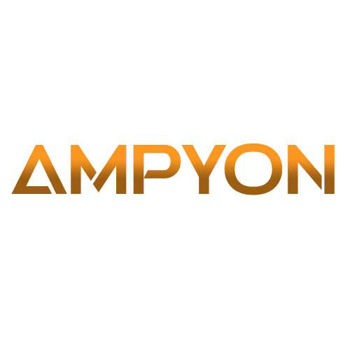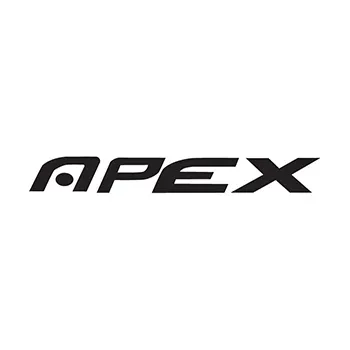Natural vs. Synthetic Stones: a practical guide to help you tell nature‑grown, lab‑grown (synthetic), and imitation stones apart—what to ask before you pay, how gemologists verify, and a 7‑step checklist so you can shop with confidence.
Table of Contents (click to expand)
Quick Answer (TL;DR)
Formed in the earth by geological processes. After mining, stones may be treated (e.g., heat), but their origin is natural.
Created in a lab yet share the same chemistry, crystal structure, and optical behavior as the natural counterpart (e.g., ruby, sapphire, diamond).
Only mimics the look (e.g., glass, cubic zirconia); properties and composition differ from the gem it imitates.
Layered stones (doublets/triplets), common in opal; legitimate when disclosed. Value and care differ from solid stones.
Definitions That Really Matter
Natural gemstones
These form entirely in nature, not manufactured by humans. After mining, they are cut and polished, and they may be treated to improve color or clarity (e.g., heating corundum, oiling/resin in emerald). Treatments are common and acceptable when clearly disclosed, especially if special care is required.
Synthetic (lab‑grown) gemstones
Made via processes such as Verneuil (flame‑fusion), flux, hydrothermal growth, or HPHT/CVD for diamond. The result is the same gem species as its natural equivalent. In plain terms: a lab‑grown ruby is still corundum; a lab‑grown diamond is still crystalline carbon. The key difference is the origin.
Simulants / imitations
Different materials (glass, resin, CZ, synthetic spinel, etc.) crafted to look like a particular gem. Because properties differ, simple gemological tests (refractive index, specific gravity, spectroscopy) or microscopic observation will separate them from the real gem they mimic.
Assembled stones
Stones made of more than one layer, such as opal doublets (thin opal layer bonded to a dark base) and triplets (opal layer + clear cap + dark base). These can be beautiful and budget‑friendly, but they are valued differently from solid stones and may be sensitive to prolonged moisture or heat.
Why the Distinction Affects Price, Care & Trust
- Pricing & rarity: Natural gems command premiums for scarcity and unique natural inclusions/zoning. Lab‑grown offers similar beauty at lower cost. Simulants are typically the most affordable.
- Care & durability: Some treatments (fracture filling, dyeing, diffusion) or constructions (doublets/triplets) change how you should clean and wear the piece (e.g., avoid ultrasonics or high heat).
- Labeling & disclosure: Clear terminology—natural vs. lab‑grown vs. imitation—and upfront disclosure of treatments protect you and reward honest sellers.
- Documentation & resale: Invoices that state the stone’s nature plus independent lab reports make insurance and future resale simpler and more credible.
Side‑by‑Side Comparison: Natural vs. Synthetic vs. Imitation
| Attribute | Natural | Synthetic (Lab‑grown) | Imitation / Simulant |
|---|---|---|---|
| Origin | Formed in the earth | Grown in a lab (flux, hydrothermal, HPHT/CVD for diamond) | Different material chosen to mimic the look |
| Chemistry & optics | Matches species (e.g., ruby = Al2O3) | Same as natural counterpart | Different from the gem being imitated |
| Typical identifiers | Natural inclusions; angular zoning; subtle color variation | Curved striae in Verneuil corundum; growth features in HPHT/CVD diamond | Rounded gas bubbles (glass); RI/SG don’t match target gem |
| Price & rarity | Usually highest (quality/origin dependent) | Lower than natural at the same quality tier | Typically lowest |
| Disclosure | Treatments must be disclosed | “Laboratory‑grown / created” must be disclosed | “Imitation / simulant” must be disclosed |
| Care | Varies by species & treatment | Similar to natural counterpart | Depends on actual material (e.g., glass scratches easily) |
At‑a‑Glance Checks for Shoppers (Helpful, Not Definitive)
- The “too perfect” test: A large, very clean, vividly colored stone at a surprisingly low price likely indicates lab‑grown or heavy treatment. Ask for documentation.
- Color uniformity: In some species (e.g., corundum), perfectly uniform color can hint at synthetics; natural gems often show subtle zoning. Request magnified photos/video and a lab report for clarity.
- Check for layers: Side‑on inspection of opal often reveals doublet/triplet layering. Value and care differ from solid opal; avoid soaking and high heat.
- Weight & feel: Glass sometimes feels unexpectedly heavy for its size; plastics/resins feel light and warm quickly in the hand.
- Surface clues: Glass can show round bubbles or “orange‑peel” texture; poorly finished facets/edges are red flags for imitations.
- Seller transparency: Trust listings that clearly state natural/lab‑grown/imitated, treatments, and care. Evasive answers? Consider another seller.
What Gemologists Look For (and Why a 10× Loupe Isn’t Enough)
Professionals combine multiple lines of evidence: microscopic inclusions and growth features, optical readings, and advanced spectroscopy. With high‑quality synthetics and sophisticated treatments, no single “naked‑eye trick” is reliable on its own.
Core instruments
- Microscope: inclusions, growth patterns (curved vs. angular striae), filler residues.
- Refractometer: refractive index (RI) and birefringence to confirm species.
- Polariscope: optic character and strain patterns.
- Dichroscope: pleochroism (color changes with crystal orientation).
- Spectroscope & UV tools: diagnostic absorption lines and fluorescence responses.
Examples of diagnostic features
- Corundum (ruby/sapphire): Verneuil synthetics often show curved striae; natural corundum shows angular zoning or “fingerprint” inclusions.
- Diamond: HPHT lab‑grown diamonds may display metallic flux inclusions or distinct strain; CVD lacks metallic flux but can show different growth features and fluorescence patterns.
- Emerald: oiling/impregnation reduces the visibility of fissures; “flash effect” and residue under magnification can reveal filling.
- Glass & resin: rounded gas bubbles, flow lines, and RI/SG mismatches compared with the claimed species.
For significant purchases (by price or sentiment), prefer an independent lab report—especially for diamond, sapphire, ruby, and emerald.
Treatments & Disclosure: What’s Normal, What to Ask
Treatments are widespread and perfectly legitimate when disclosed. What matters most is stability and care. Ask the seller to document both the treatment and the recommended care.
- Heat treatment: enhances color/clarity in many stones (e.g., corundum); typically stable and widely accepted.
- Diffusion: introduces elements (e.g., beryllium in sapphire) to add color; often concentrated near the surface—must be disclosed.
- Fracture/void filling: glass/resin fills increase transparency (e.g., lead‑glass‑filled ruby). Avoid high heat, harsh chemicals, and ultrasonic cleaners.
- Impregnation/oiling: common in emerald to reduce visible fissures; may diminish over time and require gentle care or re‑treatment.
- Irradiation/dyeing: alters color in some materials; stability varies. Sellers should state permanence and cleaning caveats.
Step‑by‑Step: Buy Confidently in 7 Moves
- Decide your priority: Natural rarity, lab‑grown value, or fashion‑friendly simulants? This choice frames all others.
- Use the right words: “Natural” ≠ “Lab‑grown/synthetic” ≠ “Imitation/simulant.” For diamonds, expect “laboratory‑grown/created.”
- Ask for it in writing: The invoice/product page should clearly state nature (natural/lab‑grown/simulant), any treatments, and special care.
- Request a recognized lab report for high‑value stones: Particularly for diamond, ruby, sapphire, and emerald.
- Compare like‑for‑like: Price stones at similar size, color, clarity, and cut. Lab‑grown should be more affordable at a given quality tier.
- Inspect construction: Confirm whether the piece is a solid stone or an assembled doublet/triplet (common in opal/inlay); care and value differ.
- Choose transparent retailers: Clear product pages, sensible returns, and knowledgeable staff who answer technical questions directly.
Ready to shop with guidance? Explore our Crystal Bracelets and Necklaces
FAQs
Are synthetic stones “fake”?
No. Lab‑grown (synthetic) stones are the same material as their natural counterparts—just grown in a controlled environment. They are real gemstones with a different origin.
Can I tell natural from lab‑grown with the naked eye?
Usually not. Some synthetics reveal growth features under a microscope or specific lighting, but reliable identification requires professional tools and, often, a lab report.
Are treated stones still considered natural?
Yes—if the base material formed in nature. However, the treatment alters appearance/clarity and should be disclosed along with any special care.
What’s the difference between a simulant and a synthetic?
A simulant only looks similar (e.g., glass “diamond”), while a synthetic is the same gem species grown in a lab (e.g., lab‑grown diamond).
Are opal doublets/triplets “fake”?
No. They are assembled stones sold legitimately as doublets/triplets, but they differ in value and care from solid opal. Avoid soaking and high heat.
Key Takeaways
Natural vs. Lab‑grown vs. Simulant are distinct categories. Choose based on your priorities: rarity, budget, or fashion flexibility.
Always seek written disclosure. For major purchases, add an independent gem lab report.
Curved striae in Verneuil corundum, bubbles in glass, and layered builds are useful hints—then verify professionally.
Assembled and fracture‑filled stones are sensitive to heat/ultrasonics/chemicals. Follow the retailer’s cleaning guidance.
Appendix: Two Lab‑Grown Diamond Methods (HPHT & CVD)
HPHT (High Pressure, High Temperature)
- Mimics deep‑earth conditions to crystallize diamond.
- May leave metallic flux inclusions; some stones show magnetic response.
- Some natural diamonds also undergo HPHT color improvement.
CVD (Chemical Vapor Deposition)
- Grows diamond layer‑by‑layer in a vacuum chamber from a carbon‑rich gas.
- No metallic flux; growth/fluorescence/strain patterns differ from HPHT.
- Producers can fine‑tune growth conditions to achieve desirable color/clarity.
Both HPHT and CVD produce real diamond. When choosing, focus on cut quality, eye appeal, and credible documentation.
Important Disclaimer
This article provides educational information about gemstones and jewelry. It is not a substitute for professional gemological testing or medical advice. For high‑value purchases, consult a qualified gemologist and obtain an independent laboratory report. Always follow the care instructions provided by your retailer.



